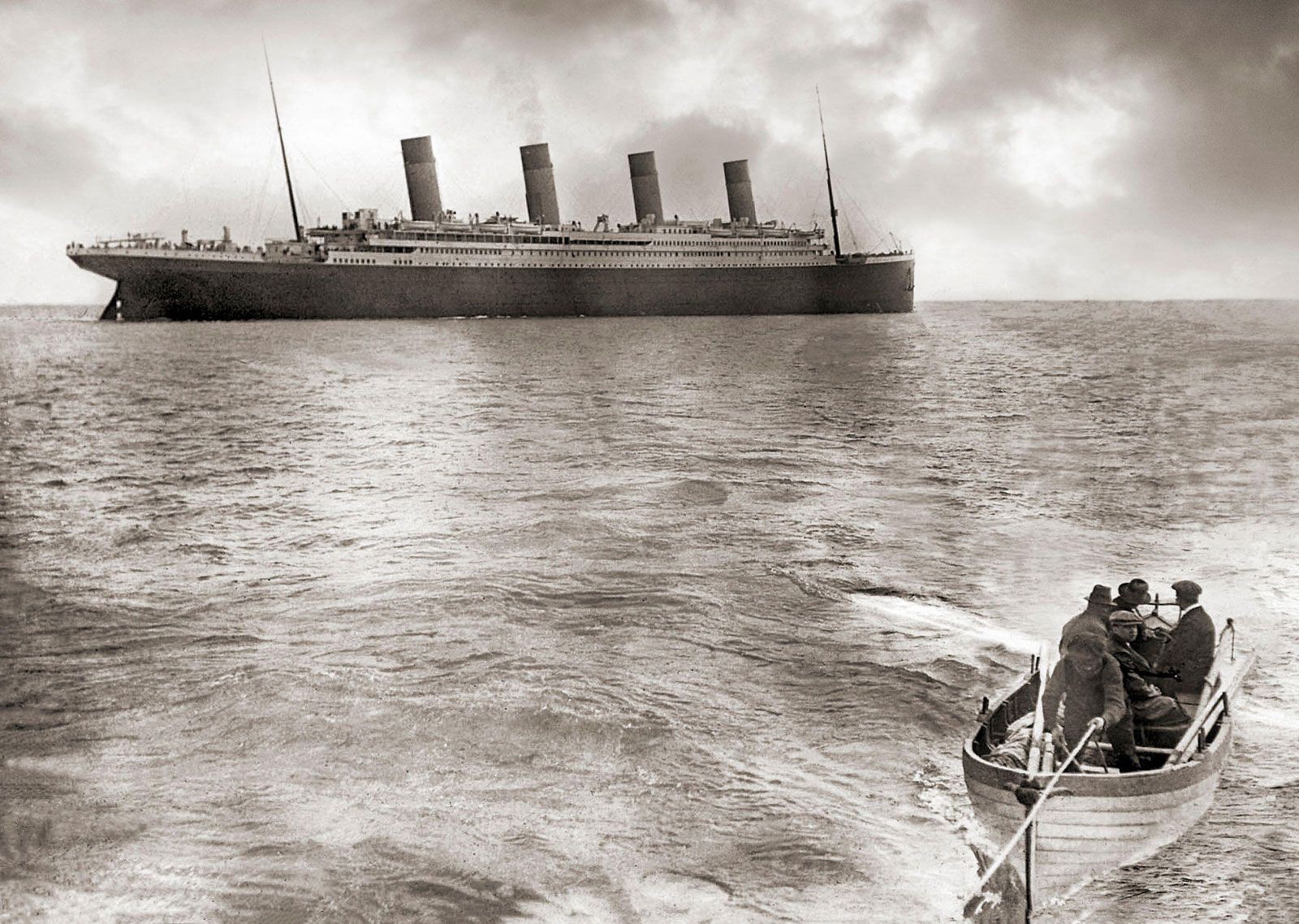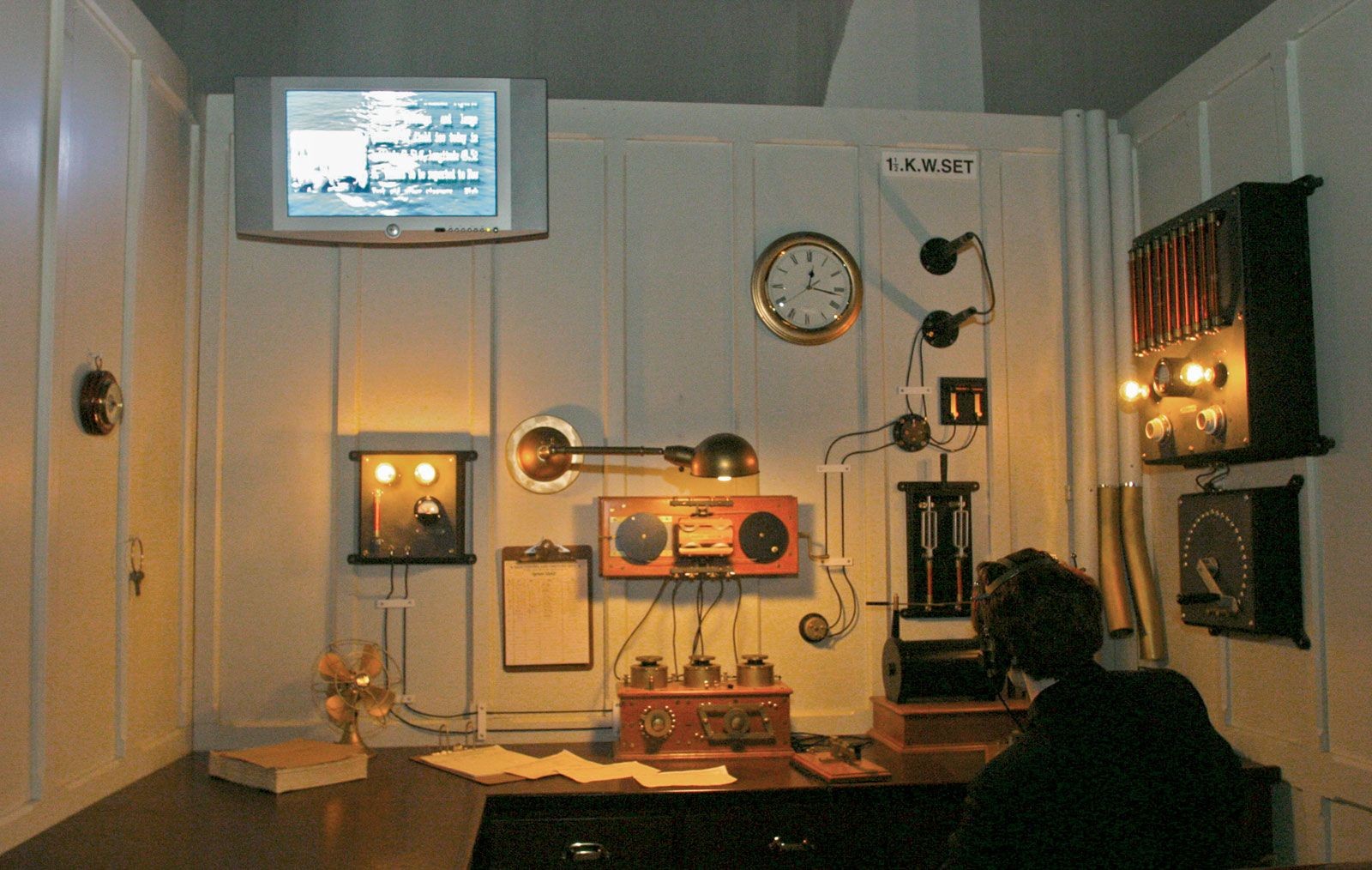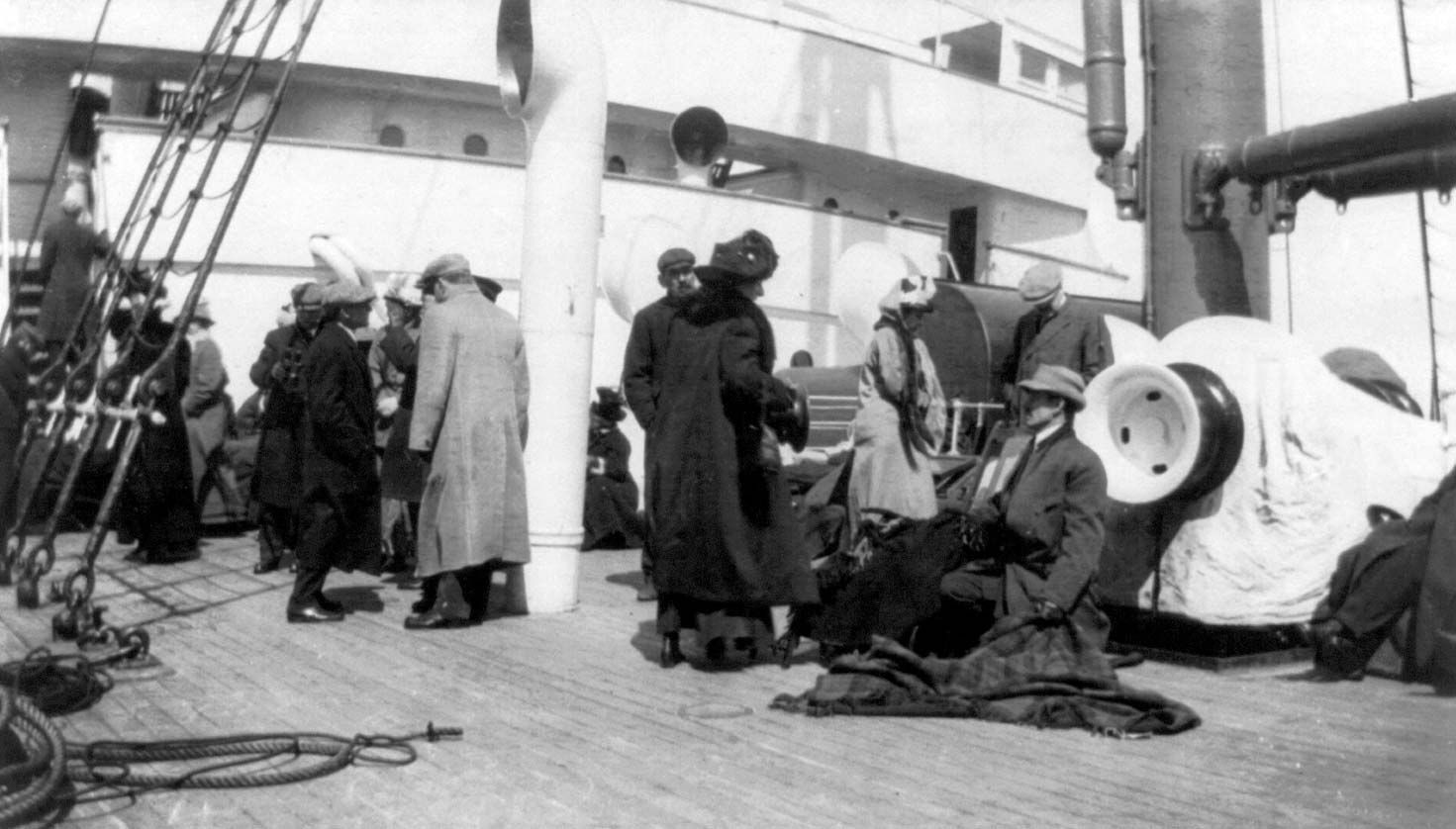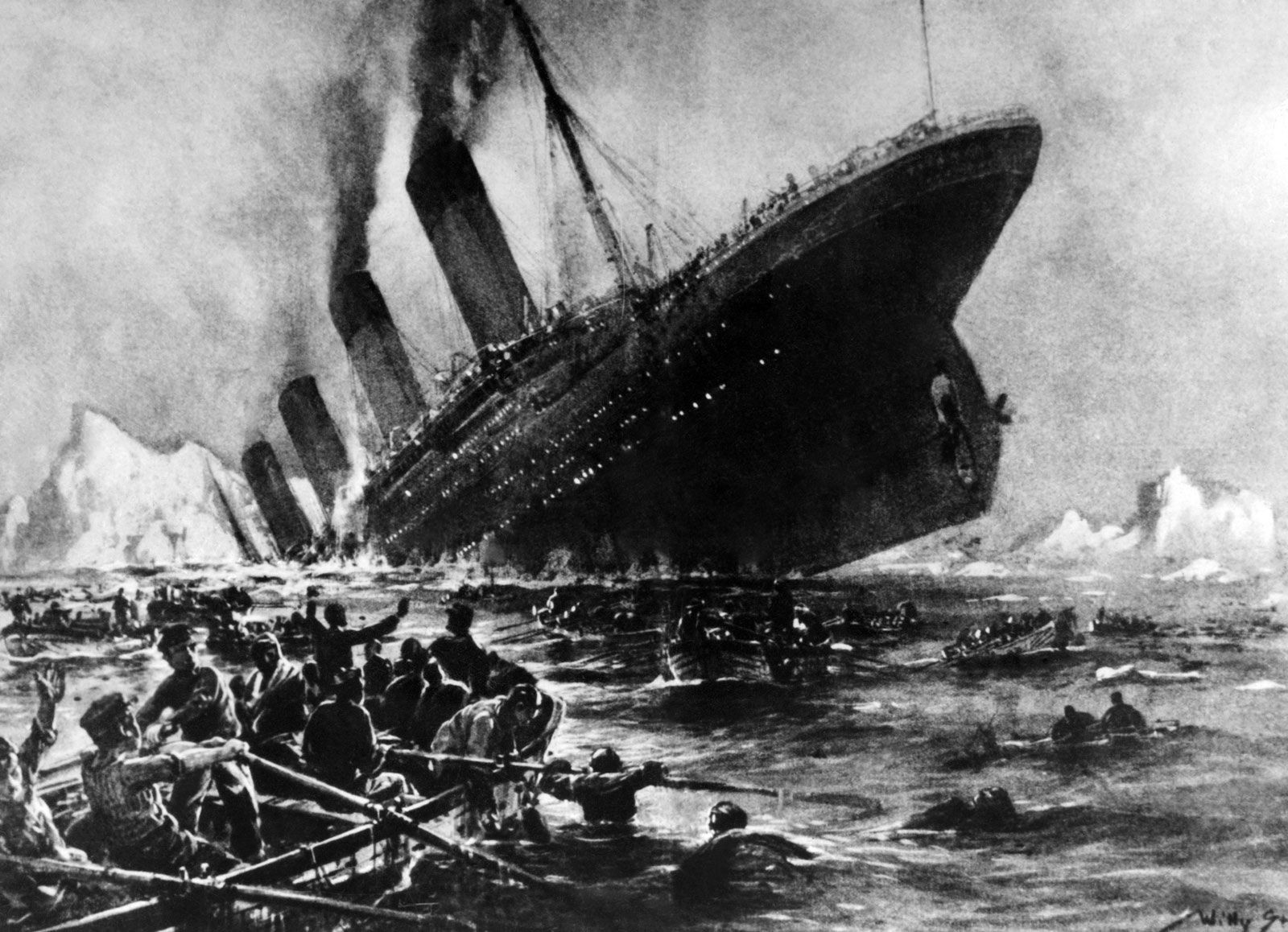How Far Did The Titanic Travel Before Sinking? The Titanic, on its maiden voyage, traveled approximately 2,689 nautical miles (3,094 miles or 4,980 kilometers) from Southampton, England, before its tragic sinking. TRAVELS.EDU.VN explores the details of this ill-fated journey, providing insights into the events leading up to the disaster, offering historical context, and highlighting the lasting impact of the Titanic. Explore the depths of maritime history and disaster analysis with this comprehensive exploration, complete with luxury travel planning advice, nautical history insights, and Titanic route analysis.
1. What Was the Titanic’s Intended Route and Actual Distance Traveled?
The Titanic’s intended route was from Southampton, England, to New York City, USA. The actual distance the Titanic traveled before sinking was approximately 2,689 nautical miles (3,094 miles or 4,980 kilometers). Let’s dive deeper into the planned itinerary versus the harsh reality of the journey.
- Departure Point: Southampton, England
- Intended Destination: New York City, USA
- Distance Traveled: Approximately 2,689 nautical miles
- Remaining Distance: Roughly 651 nautical miles to New York
Planned Route vs. Reality: The Titanic’s voyage began smoothly, but fate had other plans. Here’s a detailed breakdown of the planned stops and the actual path taken.
| Stop | Planned | Actual |
|---|---|---|
| 1. Southampton | Embarkation | Embarkation |
| 2. Cherbourg, France | Passenger Pick-Up | Passenger Pick-Up |
| 3. Queenstown (Cobh), Ireland | Last European Stop | Last European Stop |
| 4. New York City | Final Destination | Sinking in the North Atlantic Ocean |
 Titanic Leaving Cobh Ireland
Titanic Leaving Cobh Ireland
The Titanic departed from Queenstown, Ireland, on April 11, 1912.
2. When Did the Titanic Leave Southampton and When Did It Sink?
The Titanic left Southampton on April 10, 1912, and sank in the early hours of April 15, 1912. Let’s break down the timeline of this historic, yet tragic, voyage.
- Departure Date: April 10, 1912
- Sinking Date: April 15, 1912
- Voyage Duration: 4 days, 14 hours
- Time of Impact: 11:40 PM on April 14, 1912 (local time)
- Time of Sinking: 2:20 AM on April 15, 1912 (local time)
Detailed Timeline:
| Date | Event | Time (Approximate) |
|---|---|---|
| April 10 | Departure from Southampton | 12:00 PM |
| April 10 | Stop at Cherbourg, France | 6:30 PM |
| April 11 | Stop at Queenstown (Cobh), Ireland | 11:30 AM |
| April 14 | Iceberg warning received | 9:40 PM |
| April 14 | Collision with iceberg | 11:40 PM |
| April 15 | Distress signals sent | 12:20 AM |
| April 15 | Sinking of the Titanic | 2:20 AM |
| April 15 | Arrival of the Carpathia for rescue operations | 3:30 AM |
The journey of the Titanic, though intended to be a luxurious and seamless voyage, was cut short by unforeseen circumstances.
3. Where Exactly Did the Titanic Sink in the Atlantic Ocean?
The Titanic sank approximately 400 nautical miles (460 miles or 740 kilometers) south of Newfoundland, Canada, in the North Atlantic Ocean. Understanding the precise location of the disaster provides critical context to the events.
- Location: North Atlantic Ocean
- Coordinates: 41°46′N, 50°14′W
- Distance from Newfoundland: Approximately 400 nautical miles south
- Depth of Wreckage: Approximately 12,500 feet (3,800 meters)
Geographical Context: The location where the Titanic sank is in a region known for icebergs, making it a hazardous route, especially during the early months of the year.
- Iceberg Alley: The area is part of the “Iceberg Alley,” where icebergs from Greenland travel southward.
- Ocean Conditions: The cold waters of the Labrador Current meet the warmer waters of the Gulf Stream, creating dense fog and challenging visibility.
- Remote Location: The remoteness of the location complicated rescue efforts, contributing to the high loss of life.
This geographical backdrop underscores the environmental risks that contributed to the Titanic’s tragic end.
4. What Were the Primary Causes That Led to the Titanic’s Sinking?
Several factors converged to cause the Titanic’s sinking, including excessive speed, lack of binoculars for the lookouts, and delayed iceberg warnings. Let’s explore the key elements that sealed the fate of the Titanic.
- Excessive Speed: The Titanic was traveling at approximately 22 knots (25 mph or 41 km/h) in an area known to have icebergs.
- Lack of Binoculars: The crow’s nest, where lookouts Frederick Fleet and Reginald Lee were stationed, lacked binoculars, hindering their ability to spot the iceberg in time.
- Delayed Iceberg Warnings: Multiple iceberg warnings were received but not effectively communicated to the bridge, delaying critical decision-making.
- Design Flaws: The ship’s watertight compartments were not tall enough, allowing water to spill over into adjacent compartments once the bow dipped too low.
- Human Error: A combination of miscommunication, overconfidence, and procedural lapses contributed to the disaster.
 Titanic's Wireless Room
Titanic's Wireless Room
The Titanic’s wireless room played a crucial role in sending distress signals.
Detailed Breakdown of Contributing Factors:
| Factor | Description | Impact |
|---|---|---|
| High Speed | The Titanic maintained high speed despite warnings of icebergs, reducing reaction time. | Reduced the ability to maneuver and avoid the iceberg in time. |
| No Binoculars | The absence of binoculars in the crow’s nest reduced the effectiveness of the lookouts. | Delayed the sighting of the iceberg, giving the crew less time to react. |
| Missed Warnings | Critical iceberg warnings were not promptly relayed to the bridge. | Delayed necessary course corrections, increasing the risk of collision. |
| Design Limitations | The watertight compartments did not extend high enough to contain flooding from multiple breaches. | Allowed water to cascade over compartment tops, leading to progressive flooding and sinking. |
| Operational Failures | Poor communication, lack of preparedness, and overconfidence in the ship’s unsinkability. | Contributed to critical errors in judgment and response, exacerbating the disaster. |
5. How Many People Were on Board the Titanic, and How Many Survived?
Approximately 2,200 people were on board the Titanic, including passengers and crew. Only about 705 survived, highlighting the enormity of the tragedy.
- Total Onboard: Approximately 2,200
- Passengers: Approximately 1,300
- Crew: Approximately 900
- Survivors: 705
- Fatalities: Approximately 1,500
 Titanic survivors aboard the Carpathia
Titanic survivors aboard the Carpathia
Titanic survivors aboard the Carpathia in April 1912.
Survival Statistics by Class:
| Class | Total Passengers | Survivors | Survival Rate |
|---|---|---|---|
| First Class | 325 | 203 | 62.5% |
| Second Class | 285 | 118 | 41.4% |
| Third Class | 708 | 178 | 25.1% |
| Crew | 900 | 208 | 23.1% |
| Overall | 2,218 | 705 | 31.8% |
The disproportionate survival rates between classes underscore the social inequalities of the time and the prioritization of first-class passengers during the evacuation.
6. What Was the Carpathia’s Role in the Titanic Disaster?
The Carpathia, a Cunard liner, played a crucial role in rescuing survivors from the Titanic disaster. It arrived approximately 1.5 hours after the Titanic sank and picked up all the survivors from the lifeboats.
- Arrival Time: Approximately 3:30 AM on April 15, 1912
- Distance from Titanic: 58 nautical miles (67 miles or 107 km)
- Rescue Operation: Picked up 705 survivors
- Destination: New York City
- Arrival in New York: April 18, 1912
The Carpathia rescuing Titanic survivors in April 1912.
Key Actions of the Carpathia:
- Received Distress Signal: The Carpathia received the distress signal from the Titanic at approximately 12:20 AM and immediately changed course to assist.
- Increased Speed: The crew pushed the ship to its maximum speed, navigating through icy waters to reach the survivors as quickly as possible.
- Provided Medical Assistance: Once on the scene, the Carpathia’s crew provided medical care, blankets, and food to the exhausted and traumatized survivors.
- Transport to New York: The Carpathia transported the survivors to New York City, where they were met by large crowds and offered further assistance.
The Carpathia’s timely response and efficient rescue operations were vital in saving hundreds of lives amidst the catastrophic aftermath of the Titanic’s sinking.
7. How Did the Titanic Disaster Impact Maritime Safety Regulations?
The Titanic disaster led to significant changes in maritime safety regulations, including the establishment of the International Convention for the Safety of Life at Sea (SOLAS). These changes were designed to prevent similar tragedies in the future.
- International Convention for the Safety of Life at Sea (SOLAS): Established in 1914, SOLAS set international standards for maritime safety, including lifeboat capacity, emergency procedures, and communication protocols.
- Lifeboat Capacity: Regulations mandated that all ships carry enough lifeboats for everyone on board, regardless of the ship’s size.
- 24-Hour Radio Watch: Ships were required to maintain a 24-hour radio watch to ensure that distress signals were promptly received and acted upon.
- Ice Patrol: The International Ice Patrol was established to monitor iceberg activity in the North Atlantic and provide warnings to ships.
- Improved Communication Protocols: Standardized communication protocols and emergency procedures were implemented to improve coordination during crises.
Key Regulatory Changes:
| Regulation | Description | Impact |
|---|---|---|
| Sufficient Lifeboats | Ships must carry enough lifeboats for all passengers and crew. | Ensures everyone has a chance of survival in an emergency. |
| Continuous Radio Watch | Ships must maintain a 24-hour radio watch. | Ensures distress signals are promptly received and responded to. |
| International Ice Patrol | Monitors iceberg activity and provides warnings to ships. | Reduces the risk of collisions with icebergs in dangerous areas. |
| Enhanced Safety Procedures | Standardized safety drills, emergency protocols, and communication systems. | Improves crew preparedness and coordination during emergencies, increasing the chances of successful evacuation and rescue. |
These regulatory changes significantly enhanced maritime safety standards, reducing the likelihood of similar disasters and improving the safety of sea travel.
8. What Role Did J. Bruce Ismay Play in the Titanic Tragedy and Its Aftermath?
J. Bruce Ismay, the chairman and managing director of the White Star Line, played a controversial role in the Titanic tragedy. He survived the sinking, which led to public criticism and accusations of prioritizing his safety over others.
- Position: Chairman and Managing Director of the White Star Line
- Controversy: Survived the sinking while many others perished, leading to accusations of cowardice.
- Actions: His decisions regarding the ship’s speed and lifeboat capacity came under scrutiny.
- Aftermath: Faced public condemnation and testified at inquiries into the disaster.
Isidor Straus, a prominent passenger who perished on the Titanic.
Ismay’s Role and Impact:
| Aspect | Description | Impact |
|---|---|---|
| Pre-Voyage Decisions | Oversaw the design and construction of the Titanic, including decisions about the number of lifeboats. | Influenced the ship’s safety features, which were later found to be inadequate. |
| Voyage Decisions | Allegedly encouraged Captain Smith to maintain high speed to arrive in New York ahead of schedule. | Contributed to the high speed in dangerous waters, increasing the risk of collision. |
| Survival and Criticism | Boarded a lifeboat while many women and children were still on board, leading to accusations of prioritizing his safety. | Damaged his reputation and led to widespread public condemnation. |
| Testimony and Inquiries | Testified at British and American inquiries into the disaster, facing intense questioning about his actions and decisions. | Provided insights into the events leading up to the sinking but remained a controversial figure. |
Ismay’s legacy remains tarnished by the circumstances of his survival and the decisions he made before and during the Titanic’s fateful voyage.
9. How Has the Discovery of the Titanic Wreckage Site Contributed to Our Understanding of the Disaster?
The discovery of the Titanic wreckage site in 1985 by Dr. Robert Ballard has significantly enhanced our understanding of the disaster, providing valuable insights into the ship’s condition, the sinking process, and the distribution of debris.
- Discovery Date: September 1, 1985
- Discoverer: Dr. Robert Ballard and his team
- Location: Approximately 12,500 feet (3,800 meters) deep in the North Atlantic Ocean
- Findings: Revealed the ship broke apart on the surface and provided forensic details about the sinking.
 Illustration of the Titanic's sinking
Illustration of the Titanic's sinking
Illustration of the Titanic’s sinking.
Key Contributions from the Wreckage Site:
| Contribution | Description | Impact |
|---|---|---|
| Ship’s Condition | Confirmed that the Titanic broke apart on the surface, disproving earlier theories that it sank intact. | Provided crucial evidence about the structural failure of the ship and the forces it endured during the sinking. |
| Sinking Process | Detailed analysis of the wreckage revealed how the ship descended and the sequence of events that led to its final resting place. | Helped reconstruct the timeline of the sinking and understand the dynamics of the disaster. |
| Debris Field | Mapping the debris field provided insights into the distribution of artifacts and personal belongings, painting a more complete picture of the disaster. | Offered a poignant reminder of the human cost of the tragedy and provided valuable artifacts for historical analysis. |
| Forensic Evidence | Examination of the hull and other components provided forensic evidence about the impact of the iceberg and the damage sustained by the ship. | Confirmed the extent of the damage and helped determine the cause of the sinking with greater accuracy. |
| Historical and Cultural Significance | The wreckage site has become a poignant memorial to the victims and a site of ongoing research and exploration. | Reinforces the importance of preserving the Titanic’s legacy and learning from its mistakes to prevent future disasters. |
The discovery of the Titanic wreckage site has transformed our understanding of the disaster, providing invaluable forensic and historical insights that continue to shape our knowledge of this tragic event.
10. How Can I Plan a Trip to Visit Titanic-Related Historical Sites?
Planning a trip to visit Titanic-related historical sites can be a deeply moving and educational experience. TRAVELS.EDU.VN offers personalized travel planning services to help you explore these significant locations.
- Southampton, England: Visit the SeaCity Museum to learn about Southampton’s connection to the Titanic and see exhibits about the ship’s crew and passengers.
- Accommodation: The Pig in the Wall, Southampton Harbour Hotel
- Activities: Walking tour of the Titanic departure points, visit the Titanic Engineer Officers Memorial.
- Belfast, Northern Ireland: Explore the Titanic Belfast museum, located on the site where the ship was built, offering interactive exhibits and historical artifacts.
- Accommodation: The Titanic Hotel Belfast, The Merchant Hotel
- Activities: Tour of the Harland and Wolff shipyard, visit the Titanic Memorial Garden.
- Halifax, Nova Scotia, Canada: Visit the Maritime Museum of the Atlantic to see artifacts recovered from the Titanic and learn about Halifax’s role in the recovery efforts.
- Accommodation: The Lord Nelson Hotel & Suites, Muir, Autograph Collection
- Activities: Visit the Fairview Lawn Cemetery where many Titanic victims are buried, explore the Titanic exhibit at the Maritime Museum.
TRAVELS.EDU.VN Exclusive Packages:
| Destination | Package Highlights | Price (Approximate) |
|---|---|---|
| Southampton | 3-Day Tour: SeaCity Museum, Titanic Memorials, Guided City Tour, Luxury Accommodation | $800 |
| Belfast | 4-Day Tour: Titanic Belfast, Harland and Wolff Shipyard, Titanic Memorial Garden, Premium Hotel Stay | $1,200 |
| Halifax | 3-Day Tour: Maritime Museum of the Atlantic, Fairview Lawn Cemetery, Guided Historical Tour, Deluxe Accommodation | $900 |
| Multi-Destination Tour | 7-Day Tour: Southampton, Belfast, and Halifax, Including all key Titanic sites, luxury accommodations, and guided tours in each city | $3,500 |
TRAVELS.EDU.VN can customize your itinerary to include:
- Guided Tours: Expert-led tours of Titanic-related sites
- Luxury Accommodations: Stays in top-rated hotels near historical landmarks
- Transportation: Seamless travel arrangements, including flights, trains, and private transfers
- Exclusive Access: VIP access to museums and historical sites
Contact TRAVELS.EDU.VN today to plan your unforgettable journey through Titanic history!
Address: 123 Main St, Napa, CA 94559, United States
WhatsApp: +1 (707) 257-5400
Website: TRAVELS.EDU.VN
Frequently Asked Questions (FAQ) About the Titanic’s Final Voyage
1. How far from New York was the Titanic when it sank?
The Titanic was approximately 651 nautical miles (750 miles or 1,206 kilometers) from New York City when it sank. This distance highlights how close the ship was to reaching its destination.
2. What was the exact route of the Titanic’s maiden voyage?
The Titanic’s route started in Southampton, England, then stopped at Cherbourg, France, and Queenstown (Cobh), Ireland, before heading west towards New York City, where it ultimately sank in the North Atlantic.
3. How long did it take for the Titanic to sink after hitting the iceberg?
It took approximately 2 hours and 40 minutes for the Titanic to sink after it struck the iceberg. The collision occurred at 11:40 PM on April 14, 1912, and the ship disappeared beneath the waves at 2:20 AM on April 15, 1912.
4. What were the iceberg warnings the Titanic received?
The Titanic received multiple iceberg warnings throughout April 14, 1912, from various ships, including the Mesaba and the Californian. However, not all warnings were effectively communicated to the bridge, contributing to the disaster.
5. How deep is the Titanic wreckage site?
The Titanic wreckage site is located approximately 12,500 feet (3,800 meters) deep in the North Atlantic Ocean. The extreme depth and harsh conditions make exploration of the site challenging.
6. What was the speed of the Titanic when it hit the iceberg?
The Titanic was traveling at approximately 22 knots (25 mph or 41 km/h) when it struck the iceberg. This high speed in icy waters significantly reduced the crew’s ability to avoid the collision.
7. How many lifeboats were on the Titanic?
The Titanic had 20 lifeboats, which could carry only 1,178 people, far short of the approximately 2,200 passengers and crew on board. This deficiency in lifeboat capacity was a major factor contributing to the high loss of life.
8. What was the role of Captain Edward Smith during the sinking?
Captain Edward Smith was the captain of the Titanic and oversaw the ship’s operations. During the sinking, he ordered distress signals to be sent and supervised the launch of lifeboats. He reportedly went down with the ship and was never found.
9. How did the survivors of the Titanic disaster get rescued?
The survivors of the Titanic disaster were rescued by the Carpathia, a Cunard liner that arrived approximately 1.5 hours after the ship sank. The Carpathia picked up 705 survivors from the lifeboats and transported them to New York City.
10. What changes were made to maritime safety regulations after the Titanic disaster?
After the Titanic disaster, significant changes were made to maritime safety regulations, including the establishment of the International Convention for the Safety of Life at Sea (SOLAS), mandatory lifeboat drills, 24-hour radio watch requirements, and the creation of the International Ice Patrol.
Let travels.edu.vn help you uncover the full story of the Titanic and plan your next historical travel experience. With our expert guidance and personalized services, your journey will be both educational and unforgettable.